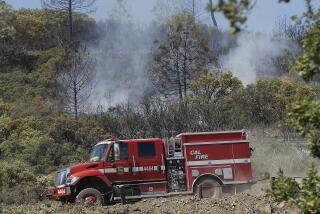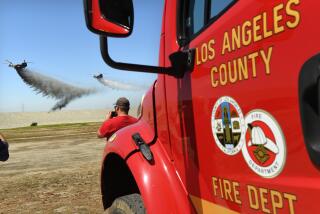Academy Immerses Students in the Firefighting Life
VALLEY GLEN â When students from James Monroe High in North Hills and Theodore Roosevelt High in Los Angeles first came together to take part in an academy for future fire fighters, they didnât immediately take to each other.
Because of the geographical divide among them, the youths mainly hung out with their own friends the first week of the academy at Los Angeles Valley College, said cadet Norberto Cuellar.
âPeople didnât know what to expect from the different communities,â said Cuellar, 16, of South Central.
Many Valley kids believed their East Los Angeles counterparts drove low riders, Cuellar said, while the East L.A. kids figured Valley youths were âdingy.â âEverybody came with little stereotypes thinking it would be like that,â he said. âThen we realized the stereotypes werenât true.â
Instructor Ralph Rodriguez, of the Los Angeles Fire Department, said he knew it was important to head off potential rivalry between the two groups and purposely mixed students from both schools in the same âcompanies.â
âWe are one unit now,â he said he told the students. âYou are no longer Monroe or Roosevelt. You are [Los Angeles] Valley College.â
Valley college was where 37 boys and girls spent much of their last six Saturdays. They learned how to unload and load fire hoses, how to connect hoses to a fire hydrant, and what it takes to be fire fighters. On Saturday the students--wearing dark blue T-shirts and caps--gathered at the college for their graduation ceremony.
As proud parents and officials watched, the cadets received certificates and displayed their skills. Heavy hoses on their shoulders, groups of six or seven students took turns dragging and connecting hoses with the proper fittings and squirting water. One team, wearing yellow coats and black helmets, took pictures.
Program Funded by Federal Grants
The Valley College FIRE (which stands for Fire, Instruction, Recruitment and Education) Academy is a partnership among the college, Los Angeles Fire Department, and Monroe and Roosevelt high schools.
Students attended for free and the academy was funded with $15,000 from two federal grants, said John C. Burke, the collegeâs Tech Prep/School to Career Director. The grants paid for instructors, equipment, lunches and transportation to the college for students without a ride, he said adding that the program will be expanded in January to include two more high schools and an intermediate division for recent graduates.
Burke said the academy offers an important opportunity for kids who are looking for a career and willing to work hard.
âIt gives them a sense of purpose. It gives them an opportunity to develop a vision of their own future,â he said. âThey have to sacrifice, give up their Saturdays.â
The cadets get a real life introduction of life inside the firehouse. They also learn to trust each other because as real fire fighters their lives depend on teamwork.
But the academy is about more than uncoiling hoses and shooting water. Cadets also learn that medical, mechanical, plumbing and public speaking skills make candidates more attractive to fire departments, said Rodriguez.
âWhen you ask the average person what does a fire fighter do, you get âput out fires,ââ said Rodriguez, 48, who has been a Los Angeles firefighter for 24 years. âThereâs so much else--we cook, we clean, we pull people out of elevators.â
Like in a real fire department, the cadets were organized in companies with captains, who were chosen according to their high scores on written tests and oral interviews.
During about 24 hours of class, the students also learned the more technical aspects of the job: They must be able to choose the right fittings quickly while connecting hoses. They also learn a fire hose is made with polyester lining to prevent it from rupturing under the 3,000 pounds of pressure it must handle.
Discipline, Not Fun and Games
Ignacio Morales, 17, said an uncle who is a fire fighter in Mexico inspired him long ago to follow in the relativeâs foot steps. He kept on his yellow coat long after completing an exercise and other cadets had removed theirs.
Yet Ignacio, of North Hills, said he was surprised by the intensity of the program. âI first thought it was fun and games. You need discipline to do this job,â he said.
The seriousness of the academy dawned on him the first time he had to unload a heavy hose and thought: âDamn, this isnât going to be just a class. Weâre actually going to do something.â
The cadets, however, never actually put out fires.
âThe hose will lift a student and knock him down,â Rodriguez said. âItâs dangerous enough.â
Soraya [cq] Vargas, 17, said she was also inspired by fire fighter relatives in Mexico City, who used to let her ride their fire truck. Unsurprisingly, her favorite part of the class was the rush she got driving the fire engine.
Although Soraya plays basketball and has competed in the Los Angeles Marathon, she said being a girl presented some challenges. Once a male cadet told her he wasnât sure she could hold a squirting hose. âIâm sure,â Soraya said she told him. âI lift weights.â
Soraya said instructor Rodriguez reminded her to carry herself confidently. âRalph taught me to look people straight in the eye,â said Soraya, of Pacoima. âYou donât have to mumble when you talk.â
Rodriguez said he hopes the academy gives a head start to students interested in fire fighting, giving them a career option that would provide a reason to complete their education.
âIf Iâm going to expose them to this kind of life,â he said, âMaybe it will stop one from dropping out of school.â
More to Read
Sign up for Essential California
The most important California stories and recommendations in your inbox every morning.
You may occasionally receive promotional content from the Los Angeles Times.










